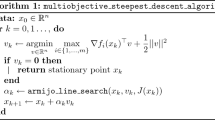Abstract
Convergence of a method of centers algorithm for solving nonlinear programming problems is considered. The algorithm is defined so that the subproblems that must be solved during its execution may be solved by finite-step procedures. Conditions are given under which the algorithm generates sequences of feasible points and constraint multiplier vectors that have accumulation points satisfying the Fritz John or the Kuhn-Tucker optimality conditions. Under stronger assumptions, linear convergence rates are established for the sequences of objective function, constraint function, feasible point, and multiplier values.
Similar content being viewed by others
References
Huard, P.,Resolution of Mathematical Programming with Nonlinear Constraints by the Method of Centers, Nonlinear Programming, Edited by J. Abadie, North-Holland Publishing Company, Amsterdam, Holland, 1967.
Faure, P., andHuard, P.,Résultats Nouveaux Relatifs à la Méthode des Centres, Paper Presented at Fourth International Conference on Operations Research, Boston, Massachusetts, 1966.
Bui-Trong-Lieu, andHuard, P.,La Méthode des Centres dans un Espace Topologique, Numerische Mathematik, Vol. 8, pp. 56–67, 1966.
Tremolières, R.,La Méthode des Centres à Troncature Variable, University of Paris, Doctoral Thesis, 1968.
Kleibohm, K.,Äquivalence eines Optimierungsproblems mit Restriktionen und einer Folge von Optimierungsproblemen ohne Restriktionen, Unternehmensforschung, Vol. 11, pp. 111–118, 1967.
Pironneau, O., andPolak, E.,On the Rate of Convergence of Certain Methods of Centers, Mathematical Programming, Vol. 2, pp. 230–257, 1972.
Polak, E.,Computational Methods in Optimization, Academic Press, New York, New York, 1971.
Zangwill, W. I.,Nonlinear Programming: A Unified Approach, Prentice-Hall, Englewood Cliffs, New Jersey, 1969.
Huard, P.,Programmation Mathématique Convexe, Revue Francaise d'Informatique et de Recherche Opérationnelle, Vol. 7, pp. 43–59, 1968.
Topkis, D. M., andVeinott, A. F.,On the Convergence of Some Feasible Direction Algorithms for Nonlinear Programming, SIAM Journal on Control, Vol. 5, pp. 268–279, 1967.
Fiacco, A. V., andMcCormick, G. P.,The Sequential Unconstrained Minimization Technique Without Parameters, Operations Research, Vol. 15, pp. 820–827, 1967.
Fiacco, A. V., andMcCormick, G. P.,Nonlinear Programming: Sequential Unconstrained Minimization Techniques, John Wiley and Sons, New York, New York, 1968.
Fiacco, A. V.,Sequential Unconstrained Minimization Methods for Nonlinear Programming, Northwestern University, Evanston, Illinois, PhD Thesis, 1967.
Frisch, K. R.,Principles of Linear Programming with Particular Reference to the Double Gradient Form of the Logarithmic Potential Method, University of Oslo, Institute of Economics, Memorandum, October 18, 1954.
Frisch, K. R.,The Logarithmic Potential Method of Convex Programming, University of Oslo, Institute of Economics, Memorandum, May 13, 1955.
Parisot, G. R.,Résolution Numerique Approchée du Problème de Programmation Linéaire par Application de la Programmation Logarithmique, Revue Francaise d'Informatique et de Recherche Opérationnelle, Vol. 20, pp. 227–259, 1961.
Lootsma, F. A.,Logarithmic Programming: A Method of Solving Nonlinear Programming Problems, Philips Research Reports, Vol. 22, pp. 329–344, 1967.
Lootsma, F. A.,Extrapolation in Logarithmic Programming, Philips Research Reports, Vol. 23, pp. 108–116, 1968.
Carroll, C. W.,The Created Response Surface Technique for Optimizing Nonlinear Restrained Systems, Operations Research, Vol. 9, pp. 169–184, 1961.
Fiacco, A. V., andMcCormick, G. P.,The Sequential Unconstrained Minimization Technique for Nonlinear Programming, A Primal-Dual Method, Management Science, Vol. 10, pp. 360–366, 1964.
Fiacco, A. V., andMcCormick, G. P.,Computational Algorithm for the Sequential Unconstrained Minimization Technique for Nonlinear Programming, Management Science, Vol. 10, pp. 601–617, 1964.
John, F.,Extremum Problems with Inequalities as Subsidiary Conditions, Studies and Essays, Courant Anniversary Volume, John Wiley and Sons (Interscience Publishers), New York, New York, pp. 187–204, 1948.
Mangasarian, O. L.,Pseudo-Convex Functions, SIAM Journal on Control, Vol. 3, pp. 281–290, 1965.
Kuhn, H. W., andTucker, A. W.,Nonlinear Programming, Proceedings of the Second Berkeley Symposium in Mathematical Statistics and Probability, Edited by J. Neyman, University of California Press, Berkeley, California, 1951.
Mifflin, R.,Convergence Bounds for Nonlinear Programming Algorithms, Mathematical Programming, Vol. 8, pp. 251–271, 1975.
Lootsma, F. A.,Boundary Properties of Penalty Functions for Constrained Minimization, Philips Research Reports, Supplement No. 3, 1970.
Faure, P.,Note Sur la Rapidité de la Convergence de la Méthode des Centres, Electricité de France, Note EDF No. HR-7504/5, 1975.
Lootsma, F. A.,Constrained Optimization via Parameter-Free Penalty Functions, Philips Research Reports, Vol. 23, pp. 424–437, 1968.
Poljak, B. T.,Existence Theorems and Convergence of Minimizing Sequences in Extremum Problems with Restrictions, Soviet Mathematics, Vol. 7, pp. 72–75, 1966.
Topkis, D. M.,Cutting Plane Methods Without Nested Constraint Sets, Operations Research, Vol. 18, pp. 404–413, 1970.
Rockafellar, R. T.,Convex Analysis, Princeton University Press, Princeton, New Jersey, 1970.
Lootsma, F. A.,Constrained Optimization via Penalty Functions, Philips Research Reports, Vol. 23, pp. 408–423, 1968.
Kortanek, K. O., andEvans, J. P.,Pseudo-Concave Programming and Lagrange Regularity, Operations Research, Vol. 15, pp. 882–891, 1967.
Mangasarian, O. L.,Nonlinear Programming, McGraw-Hill Book Company, New York, New York, 1969.
Penrose, R.,A Generalized Inverse for Matrices, Proceedings of the Cambridge Philosophical Society, Vol. 51, pp. 406–413, 1955.
Mifflin, R.,Subproblem and Overall Convergence for a Method of Centers Algorithm, Operations Research, Vol. 23, pp. 796–809, 1975.
Author information
Authors and Affiliations
Additional information
Communicated by G. L. Nemhauser
This work was supported in part by the National Aeronautics and Space Administration, Predoctoral Traineeship No. NsG(T)-117, and by the National Science Foundation, Grants No. GP-25081 and No. GK-32710.
The author wishes to thank Donald M. Topkis for his valuable criticism of an earlier version of this paper and a referee for his helpful comments.
Rights and permissions
About this article
Cite this article
Mifflin, R. Rates of convergence for a method of centers algorithm. J Optim Theory Appl 18, 199–228 (1976). https://doi.org/10.1007/BF00935704
Issue Date:
DOI: https://doi.org/10.1007/BF00935704



